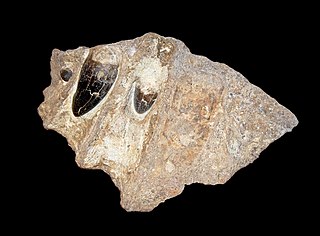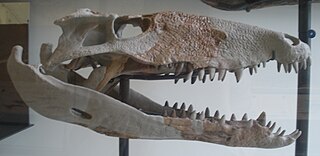
Razanandrongobe is a genus of carnivorous ziphosuchian crocodyliform from the Middle Jurassic of Madagascar. It contains the type and only species Razanandrongobe sakalavae, named in 2004 by Simone Maganuco and colleagues based on isolated bones found in 2003. The remains, which included a fragment of maxilla and teeth, originated from the Bathonian-aged Sakaraha Formation of Mahajanga, Madagascar. While they clearly belonged to a member of the Archosauria, Maganuco and colleagues refrained from assigning the genus to a specific group because the fragmentary remains resembled lineages among both the theropod dinosaurs and crocodylomorphs.

Baurusuchus is an extinct genus of baurusuchid mesoeucrocodylian, which lived in Brazil from 90 to 83.5 million years ago, in the Late Cretaceous period. It was a terrestrial predator and scavenger, estimated to reach up to 113.4 kilograms (250 lb) in weight. Baurusuchus lived during the Turonian to Santonian stages of the Late Cretaceous Period, in Adamantina Formation, Brazil. It gets its name from the Brazilian Bauru Group. It was related to the earlier-named Cynodontosuchus rothi, which was smaller, with weaker dentition. The three species are B. pachechoi, named after Eng Joviano Pacheco, its discoverer, B. salgadoensis and B. albertoi. The latter species is disputed. Its relatives include the similarly sized Stratiotosuchus from the Adamantina Formation, and Pabweshi, from the Pakistani Pab Formation.

Notosuchia is a suborder of primarily Gondwanan mesoeucrocodylian crocodylomorphs that lived during the Jurassic and Cretaceous. Some phylogenies recover Sebecosuchia as a clade within Notosuchia, others as a sister group ; if Sebecosuchia is included within Notosuchia its existence is pushed into the Middle Miocene, about 11 million years ago. Fossils have been found from South America, Africa, Asia, and Europe. Notosuchia was a clade of terrestrial crocodilians that evolved a range of feeding behaviours, including herbivory (Chimaerasuchus), omnivory (Simosuchus), and terrestrial hypercarnivory (Baurusuchus). It included many members with highly derived traits unusual for crocodylomorphs, including mammal-like teeth, flexible bands of shield-like body armor similar to those of armadillos (Armadillosuchus), and possibly fleshy cheeks and pig-like snouts (Notosuchus). The suborder was first named in 1971 by Zulma Gasparini and has since undergone many phylogenetic revisions.

Baurusuchidae is a Gondwanan family of mesoeucrocodylians that lived during the Late Cretaceous. It is a group of terrestrial hypercarnivorous crocodilians from South America and possibly Pakistan. Baurusuchidae has been, in accordance with the PhyloCode, officially defined as the least inclusive clade containing Cynodontosuchus rothi, Pissarrachampsa sera, and Baurusuchus pachecoi. Baurusuchids have been placed in the suborder Baurusuchia, and two subfamilies have been proposed: Baurusuchinae and Pissarrachampsinae.
The Adamantina Formation is a geological formation in the Bauru Basin of western São Paulo state, in southeastern Brazil.
Pabwehshi is an extinct genus of mesoeucrocodylian. It is based on GSP-UM 2000, a partial snout and corresponding lower jaw elements, with another snout assigned to it. These specimens were found in Maastrichtian-age Upper Cretaceous rocks of the Vitakri and Pab Formations in Balochistan, Pakistan, and represent the first diagnostic crocodyliform fossils from Cretaceous rocks of South Asia. Pabwehshi had serrated interlocking teeth in its snout that formed a "zig-zag" cutting edge. Pabwehshi was named in 2001 by Jeffrey A. Wilson and colleagues. The type species is P. pakistanensis, in reference to the nation where it was found. It was traditionally classified as a baurusuchid closely related to Cynodontosuchus and Baurusuchus. Larsson and Sues (2007) found close affinity between Pabwehshi and the Peirosauridae within Sebecia. Montefeltro et al.Pabwehshi has a sagittal torus on its maxillary palatal shelves – a character that is absent in baurusuchids – but they did not include Pabwehshi in their phylogenetic analysis.

Bergisuchus is an extinct genus of small sebecosuchian mesoeucrocodylian known primarily from the Eocene Messel Pit in Germany. Few fossils of Bergisuchus have been discovered, only a single incomplete snout, a few partial lower jaws and some teeth. Despite being fragmentary, the jaw bones are enough to indicate that Bergisuchus had a short, deep, narrow snout and serrated teeth, quite unlike the broad flat snouts of modern crocodylians.

Metasuchia is a major clade within the superorder Crocodylomorpha. It is split into two main groups, Notosuchia and Neosuchia. Notosuchia is an extinct group that contains primarily small-bodied Cretaceous taxa with heterodont dentition. Neosuchia includes the extant crocodylians and basal taxa, such as peirosaurids and pholidosaurids. It is phylogenetically defined by Sereno et al. (2001) as a clade containing Notosuchus terrestris, Crocodylus niloticus, and all descendants of their common ancestor.

Sebecus is an extinct genus of sebecid crocodylomorph from Eocene of South America. Like other sebecosuchians, it was entirely terrestrial and carnivorous. The genus is currently represented by two species, the type S. icaeorhinus and S. ayrampu. Several other species have been referred to Sebecus, but were later reclassified as their own genera.

Sebecia is an extinct clade of mesoeucrocodylian crocodyliforms that includes peirosaurids and sebecids. It was first constructed in 2007 to include Hamadasuchus, Peirosauridae, and Sebecus. It was initially considered to be the sister taxon of the clade Neosuchia, which includes living crocodilians, although some later studies have placed it within Neosuchia as a basal clade. Sebecians were terrestrial crocodyliforms characterized by their deep snouts and ziphodont dentition. They first appeared in the Late Cretaceous, survived the Cretaceous–Paleogene extinction event, and became extinct in the Miocene epoch.
Sebecosuchia is an extinct group of mesoeucrocodylian crocodyliforms that includes the families Sebecidae and Baurusuchidae. The group was long thought to have first appeared in the Late Cretaceous with the baurusuchids and become extinct in the Miocene with the last sebecids, but Razanandrongobe pushes the origin of Sebecosuchia to the Middle Jurassic. Fossils have been found primarily from South America but have also been found in Europe, North Africa, Madagascar, and the Indian subcontinent.

Susisuchus is an extinct genus of neosuchian mesoeucrocodylian crocodyliform from the Early Cretaceous of Brazil. Fossils have been found from the Nova Olinda Member of the Aptian-age Crato Formation in the Araripe and Lima Campos Basins of northeastern Brazil. Named in 2003, Susisuchus is the sole member of the family Susisuchidae, and is closely related to the clade Eusuchia, which includes living crocodilians. The type species is S. anatoceps, known from a single partial articulated skeleton that preserves some soft tissue. A second species, S. jaguaribensis, was named in 2009 from fragmentary remains.
Pepesuchus is an extinct genus of carnivorous metasuchian from the Late Cretaceous period. It is a peirosaurid which lived during the Campanian and Maastrichtian stages of the Late Cretaceous in what is now state of São Paulo, Brazil. It was a semiaquatic crocodylomorph.

Campinasuchus is an extinct genus of baurusuchid mesoeucrocodylian from Minas Gerais State of Brazil.

Pissarrachampsa is an extinct genus of baurusuchid mesoeucrocodylian from the Late Cretaceous of Brazil. It is based on a nearly complete skull and a referred partial skull and lower jaw from the ?Campanian - ?Maastrichtian-age Vale do Rio do Peixe Formation of the Bauru Group, found in the vicinity of Gurinhatã, Brazil.

Pissarrachampsinae is a subfamily of baurusuchid crocodyliforms from the Late Cretaceous of Brazil and Argentina. It was named in 2011 with the description of Pissarrachampsa sera and includes P. sera from Brazil and the related Wargosuchus australis from Argentina. Pissarrachampsinae is one of two subfamilies of Baurusuchidae, the other being Baurusuchinae.

Baurusuchinae is a subfamily of baurusuchid crocodyliforms from the Late Cretaceous of Brazil. Named in 2011, it contains the baurusuchids Aphaurosuchus, Aplestosuchus, Baurusuchus and Stratiotosuchus. Baurusuchinae is one of two subfamilies of Baurusuchidae, the other being Pissarrachampsinae.

Aplestosuchus is an extinct genus of baurusuchid mesoeucrocodylian known from the Late Cretaceous Adamantina Formation of São Paulo, southern Brazil. It contains a single species, Aplestosuchus sordidus. A. sordidus is represented by a single articulated and nearly complete skeleton, preserving the remains of an unidentified sphagesaurid crocodyliform in its abdominal cavity. The specimen represents direct evidence of predation between different taxa of crocodyliforms in the fossil record.
Aphaurosuchus is an extinct genus of baurusuchid mesoeucrocodylian known from the Late Cretaceous Bauru Basin of São Paulo, southern Brazil. It contains two species, Aphaurosuchus escharafacies and Aphaurosuchus kaiju.
Titanochampsa is a genus of large mesoeucrocodylian from the Maastrichtian Marilia Formation of Brazil. Although only known from a single skull roof, the material shows that Titanochampsa was not a member of Notosuchia, which were previously believed to have been the only crocodyliforms present in the strata of the Bauru Group. Body size estimates vary greatly and range between 2.98–5.88 m due to the incomplete nature of the holotype fossil. The overall anatomy of the skull roof, alongside its size and possible affinities with Neosuchians, may suggest that it was a semi-aquatic ambush hunter similar to modern crocodilians.











